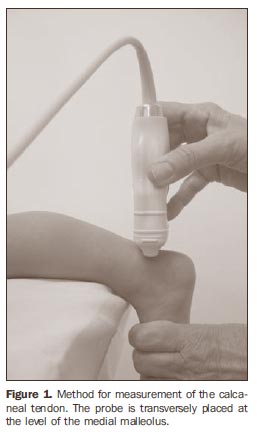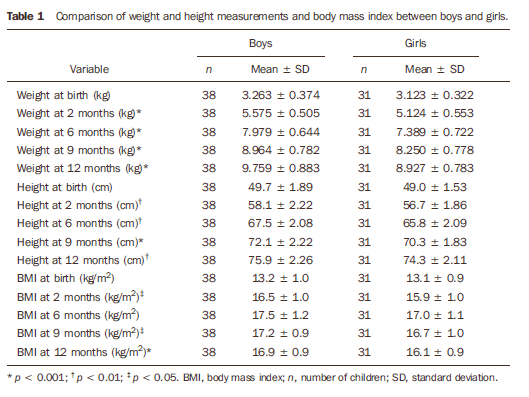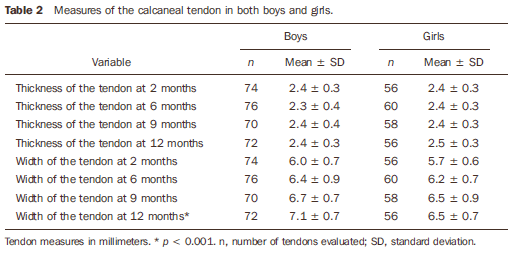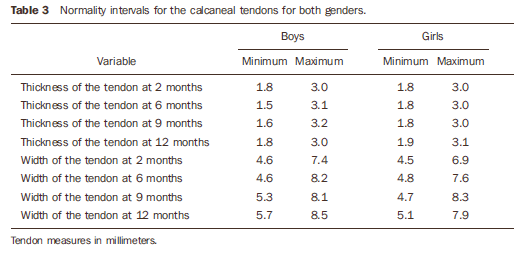Radiologia Brasileira - Publicação Científica Oficial do Colégio Brasileiro de Radiologia
AMB - Associação Médica Brasileira CNA - Comissão Nacional de Acreditação
 Vol. 42 nº 3 - May / June of 2009
Vol. 42 nº 3 - May / June of 2009
|
ORIGINAL ARTICLE
|
|
Measurements of the calcaneal tendon in the first year of life |
|
|
Autho(rs): Ricardo Flávio de Araújo Bezerra, Dioclécio Campos Júnior, Vera Lúcia Vilar de Araújo Bezerra, Augusto Cesar Bittencourt Pires Júnior, Alexandre Sérgio de Araújo Bezerra |
|
|
Keywords: Calcaneal tendon, Ultrasonography, Children |
|
|
Abstract:
IMaster, Professor of Human Anatomy, Universidade Católica de Brasília (UCB), Brasília, DF, Brazil
INTRODUCTION The soleus and gastrocnemius are located in the superficial group of the posterior crural muscles. Both muscles insert into the calcaneus - one of the seven tarsal bones - by means of the calcaneal tendon, also called the Achilles tendon. This can be easily palpated and visualized by imaging resources, since it is a superficial structure(1). A previous study has found significantly thicker calcaneal tendons in children above 3 years of age with a history of familial hypercholesterolemia, than in those included in a control group(2). According to the authors, the cause for such thickening was the abnormal development of fat deposits (xanthomas) in the respective tendon. Another study developed with adults, has found thicker calcaneal tendons in individuals with familial hypercholesterolemia and myocardial ischemia as compared with other individuals also with familial hypercholesterolemia, however with no myocardial ischemia, independently of age(3). Therefore, it is possible that persons with relatively thick calcaneal tendons are more susceptible to cardiac ischemia than persons with thinner ones(4). Thus, this is the relevance of data on measurements of the calcaneal tendon in children, as an early treatment could avoid future complications of this condition. No study was found in literature with measurements of thickness and width of calcaneal tendons in children up to 12 months of age. Therefore the need to fill in this knowledge gap was the motivating factor leading to the present research. The objective of this study was to determine the thickness and width of the calcaneal tendons by means of ultrasonography in both male and female eutrophic children at 2, 6, 9 and 12 months of age, and define their normality intervals.
MATERIALS AND METHODS The present study was evaluated by the Committee for Ethics in Research of the author's Institution and, after approval the guardians of the participating children signed a Term of Free and Informed Consent. The sample of the present study included all the children undergoing follow-up in the Ambulatory of Growth and Development of the Institution. All of them were born in the period between November 25, 2005 and July 5, 2006, and participated in the study with their parents' consent. The children, in a total of 88, 44 boys and 44 girls, were followed-up for a one-year period, with measurement of their height and weight at 2, 6, 9 and 12 months of age. Weight and height were measured at each one of those months. Based on these measurements, the body mass index (BMI) - weight (kg)/height2 (m) - was calculated for each of the children. Along the follow-up, some of the children were excluded because of malnutrition or obesity as a result of the BMI calculation. Six boys were excluded: three for malnutrition and three for obesity. Thirteen girls were excluded; six of them for malnutrition, six for obesity and one with both malnutrition and obesity at the different phases of the study. Therefore, 38 boys (76 tendons) and 31 girls (62 tendons) remained in the study group. In these same periods, the thickness and width of left and right calcaneal tendons were measured by means of ultrasonography, always by the same radiologist with experience in musculoskeletal ultrasonography. During the examination, each child was placed in ventral decubitus on an examination table, with both feet suspended. The feet were kept at a 90º angle relative to the legs, in order to facilitate the contact between the probe and the tendon (Figure 1). Cross sectional images were obtained at the level of the medial malleolus, allowing the measurement of the thickness and width of the calcaneal tendons. An EnVisor HD unit (Philips; Eindhoven, Holland) coupled with a 14-MHz linear probe was utilized for the measurements.
Sample descriptive data were separately obtained for each gender, and represented by mean and standard deviation. Means and standard deviations were calculated for thickness and width of the calcaneal tendons for all of the children at 2, 6, 9, and 12 months of age. An analysis of variance was undertaken in order to verify possible differences among tendons measurements along the months. Normality intervals for the tendons measurements were delimitated utilizing an amplitude of plus or minus two standard deviations from the average measures.
RESULTS Table 1 presents a comparison between boys and girls measurements for weight, height and BMI. Student's t-test was utilized to evaluate statistically significant differences. Statistically significant differences were found for the weight and height variables at 2, 6, 9 and 12 months, as well as for BMI at 2, 9 and 12 months.
Among the 38 boys (76 tendons) kept in the research, one did not have the calcaneal tendon measurements at 9 months, another one at 9 and 12 months, and a third one at 2, 9, and 12 months. Among the remaining 31 girls (62 tendons), three did not have the measurements of the tendons taken at 2 months, one at 6 months, another one at 9 months, and two others did not have the measurements taken at 12 months. An eighth girl did not have the tendon measures taken at 9 and 12 months. Student's t-test was utilized to evaluate statistically significant differences between the left and right calcaneal tendons thickness and width of the same tendons on both sides, for both male and female children at all ages studied. There was no statistically significant difference between the thickness of left and right tendons for the boys (p = 0.810; 0.610; 0.841 and 0.461 at 2, 6, 9 e 12 months of age, respectively) and neither for the girls (p = 0.282; 0.486; 0.577 and 0.870 at 2, 6, 9 e 12 months of age respectively). Also, there was no statistically significant difference between left and right tendons width for the boys (p = 0.071; 0.808; 0.944 and 0.642 at 2, 6, 9 e 12 months of age) and for the girls (p = 0.818; 0.669, 0.517 and 0.653 at 2, 6, 9 and 12 months of age). These results allowed joining the left and right calcaneal tendons into a single tendon sample for each gender and age. Table 2 presents the measures of the calcaneal tendons for both boys and girls, side by side. Student's t-test demonstrated a statistically significant difference between genders only for width at 12 months. An analysis of variance was undertaken for determining statistically significant variations of tendon dimensions between boys and girls along the months. No difference for the variable thickness along the months was observed in the boys. As regards the width, differences were found between means of all four months studied. No difference for the variable thickness along the months was observed in the girls. As regards to the width, differences were found between averages from the second to the sixth month and from the sixth to the ninth month. However no statistically significant difference was found between the ninth and the twelfth month. The normality intervals obtained for both boys and girls are shown on Table 3.
DISCUSSION When measuring the calcaneal tendon of a child and values are higher than the normality intervals, it is possible that there are, for example, xanthomas in this tendon, and that the child presents familial hypercholesterolemia(2). If that is the case, a treatment could be immediately started, avoiding future problems resulting from such condition. Several previous, cross sectional studies have measured the calcaneal tendons in adults, however without separating data according to gender(5-9). Among the studies reviewed in the literature, only the study by Mello et al. has been developed in Brazil. This cross sectional study, was developed with individuals aged above 20, and presented measurements of tendon width and thickness for both genders(10). No record was found in the literature about measurements of calcaneal tendon in children up to 12 months of age, except for a cross sectional study developed by Bialik et al.(11). However, these authors measured only the length of the tendons and not the width and thickness. In this sense, the present study innovates, and may contribute to a more comprehensive knowledge of the normal growth standard for the calcaneal tendon. Bialik et al. have obtained two measurements for the length of the calcaneal tendon (from the muscle-tendon junction to insertion into the calcaneus): one with the foot in dorsiflexion, and the other with the foot in plantar flexion. The average age of the children, who were not separated by gender, was 4 months (amplitude from 2 weeks to 12 months). In dorsiflexion, the mean tendon length was 37 mm, and in plantar flexion, the mean tendon length was 30.1 mm. A positive correlation between age and tendon length(11) was also observed. The study developed by Mello et al. with adults has demonstrated differences in tendon thickness and width between male and female individuals, with higher values for the male group(10). However, data from the present study demonstrate that during the first year of life there is no statistically significant difference in the mean calcaneal tendon thickness between boys and girls. As regards the tendon width, it increases along the months, with statistically higher values for the boys, only at 12 months. Brushøj et al. have evaluated the reproducibility of measurements obtained by two observers, for the calcaneal tendons, and for the tendons of the tibialis anterior and the flexor hallucis longus muscles in adults. Among these three tendons, the one presenting the smallest interobserver variation was the calcaneal tendon(12). In spite of such smaller variability in measurements of the calcaneal tendon, in the present study with children, all the measurements were performed by a single radiologist. In the study by Brushøj et al., the intraobserver reproducibility has been also evaluated. Again, the tendon with smallest variation was the calcaneal. Additionally, according to these authors, small variations in tendon measurements obtained by ultrasonography may be caused by the pressure applied by the transducer on the tendon surrounding structures, or by the positioning of the transducer at different angles(12). In the present study, the transducer was always perpendicularly positioned in relation to the calcaneal tendon. Bialik et al. have measured different lengths of the calcaneal tendon, according to the foot positioning in the sagittal plane, that is, in dorsiflexion or plantar flexion(11). This means that small movements of the foot probably generate small changes in thickness and width of the tendon. In the present study, the foot remained perpendicularly positioned in relation to the leg. The calcaneal tendon measurements may vary because of causes besides the formation of xanthomas, such as trauma or inflammation generally caused by high-level sport practice(6,13). However, considering that the present study was performed with infants < 12 months of age, it is unlikely that such factors have played a role in the alteration of tendon dimensions. As a prospect of future studies, the authors envision performing a study with children up to 12 months of age, comparing the calcaneal tendon measurements between children with normal cholesterol levels, and children with familial hypercholesterolemia. Finally, as a conclusion, the present study demonstrates that in the first year of life the thickness of the calcaneal tendon remains stable for both genders, and that the tendon width increases progressively during the first year of life, with normality standards being established in the present study.
REFERENCES 1. Koivunen-Niemelä T, Parkkola K. Anatomy of the Achilles tendon (tendo calcaneus) with respect to tendon thickness measurements. Surg Radiol Anat. 1995;17:263-8. [ ] 2. Koivunen-Niemelä T, Viikari J, Niinikoski H, et al. Sonography in the detection of achilles tendon xanthomata in children with familial hypercholesterolaemia. Acta Paediatr. 1994;83:1178-81. [ ] 3. Mabuchi H, Tatami R, Haba T, et al. Achilles tendon thickness and ischemic heart disease in familial hypercholesterolemia. Metabolism. 1978; 27:1672-9. [ ] 4. Lehtonen A, Mäkelä P, Viikari J, et al. Achilles tendon thickness in hypercholesterolaemia. Ann Clin Res. 1981;13:39-44. [ ] 5. Ebeling T, Farin P, Pyörälä K. Ultrasonography in the detection of Achilles tendon xanthomata in heterozygous familial hypercholesterolemia. Atherosclerosis. 1992;97:217-28. [ ] 6. Fornage BD. Achilles tendon: US examination. Radiology. 1986;159:759-64. [ ] 7. Mathieson JR, Connell DG, Cooperberg PL, et al. Sonography of the Achilles tendon and adjacent bursae. AJR Am J Roentgenol. 1988;151:127-31. [ ] 8. Pang BS, Ying M. Sonographic measurement of achilles tendons in asymptomatic subjects: variation with age, body height, and dominance of ankle. J Ultrasound Med. 2006;25:1291-6. [ ] 9. Steinmetz A, Schmitt W, Schuler P, et al. Ultrasonography of achilles tendons in primary hypercholesterolemia. Comparison with computed tomography. Atherosclerosis. 1988;74:231-9. [ ] 10. Mello RAF, Marchiori E, Santos AASMD, et al. Avaliação morfométrica do tendão de Aquiles por ultra-sonografia. Radiol Bras. 2006;39:161-5. [ ] 11. Bialik V, Farhoud F, Eidelman M, et al. Achilles tendon length in children evaluated sonographically. J Pediatr Orthop B. 2007;16:281-6. [ ] 12. Brushøj C, Henriksen BM, Albrecht-Beste E, et al. Reproducibility of ultrasound and magnetic resonance imaging measurements of tendon size. Acta Radiol. 2006;47:954-9. [ ] 13. Bordalo-Rodrigues M. Avaliação morfométrica do tendão de Aquiles por ultra-sonografia [editorial]. Radiol Bras. 2006;39(3):iii. [ ] Received December 16, 2008. * Study developed at Hospital Universitário de Brasília (HUB), Brasília, DF, Brazil. |
|
Av. Paulista, 37 - 7° andar - Conj. 71 - CEP 01311-902 - São Paulo - SP - Brazil - Phone: (11) 3372-4544 - Fax: (11) 3372-4554




